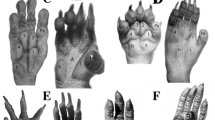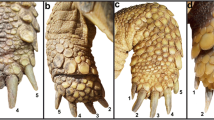Abstract
Bilateral palmar prints of 3000 males belonging to 20 endogamous Dhangar castes of Maharashtra, India, have been analysed for types and combinations of axial triradii after Cummins and Midlo (1943). Altogether 17 types of axial triradii were found among the Dhangars, but only typest, t′, tt″ occur in appreciable frequencies. The magnitude of intercaste differentiation in respect to axial triradii is considerably low; only 13 caste-pairs (6.84%) out of 190 pairs showed significant difference at the 5% level. Compared to several other palmar elements, like palmar true patterns, main line terminations, palmar flexion creases, the axial triradius has a considerably low level of differentiation among these nomadic, seminomadic and settled Dhangar castes. This suggests that the axial triradii are perhaps more stable compared to many other palmar elements. These results need to be confirmed by data from other populations.
Similar content being viewed by others
References
Bansal I. J. S., 1967.Palmar dermatoglyphics of the Budhist Ladakhis. J. Ind. Anthrop. Soc., 2:145–151.
Beckman L., Gustavson K. H. &Norring A., 1962.Finger and palm dermal ridge patterns in normal and mongoloid individuals (the Down syndrome). Acta Genet. (Besel), 12:20.
Bhasin M. K., 1964.A study of the palmar dermatoglyphics of the Bhutanes. The Anthropologist, 11:40–60.
Bhasin M. K., 1969.Symmetry of palmar mainlines, configurational areas, axial triradii and main line Index in the Newars of Nepal. The Anthropologist, Special Volume: 209–216.
Bhattacharya D. K., 1964.The palmar dermatoglyphics of the Anglo Indians of India. Z. Morph. Anthrop., 55: 357–367.
Chakravartti M. R., 1959.Dermatoglyphics of the Pahiras of Dalma Hills. Man in India, 39: 1–19.
Chakravartti M. R., 1960.Dermatoglyphics of the Santals of West Bengal., Bull. Anthrop. Survey of India, 9:41–52.
Cummins H., 1939.Dermatoglyphic stigmata in mongoloid imbeciles. Anat. Rec. 73:407.
Cummins H. &Midlo C., 1943.Finger Print, Palms and Soles. New York, Dover Publication.
Goodman R.M., Bat-Miriam Katznelson M. &Manor E., 1972.Camptodactyly: Occurrence in two genetic syndromes and its relationship to other syndromes. J. Med. Genet., 9: 203.
Das B. M., 1966.On the palm prints of the Hajong. Man in India, 46: 248–255.
Hunter H., 1968.Finger and palm prints in chromatin-positive males. J. Med. Genet., 5: 112.
Karmakar B. & Malhotra K. C., 1986a.Variation in palmar patterns among 20 Dhangar castes of Maharashtra, India (manuscript).
Karmakar B. & Malhotra K. C., 1986b.Terminations of palmar main lines among 20 Dhangar castes of Maharashtra, India (manuscript).
Malhotra K. C., 1979a.Inbreeding among Dhangar castes of Maharashtra, India. J. Biosocial Sci. 11: 397–410.
Malhotra K. C., 1979b.Qualitative finger dermatoglyphic variation among 21 endogamous Dhangar castes of Maharashtra. In: Dermatoglyphics Fifty Years later. (Eds.) W. Wertelecki and C.C. Plato. Birth Defects Original Article Series 15 (6):335–345.
Malhotra K. C., Chakraborty R. &Chakravartti A., 1978.Gene differentiation among the Dhangar caste-cluster of Maharashtra, India. Hum. Hered. 28: 26–36.
Malhotra K. C., Das S. K., Mukherjee B. N., Majumder P. P., Undevia J. V., Bhanu B. V. &Yee S., 1977.Distribution of blood groups among 21 Dhangar castes of Maharashtra. Ind. J. Phys. Anthrop. & Hum. Genet., 3:141–159.
Malhotra K. C., Reddy B. M., Karmakar B. & Vijaykumar M., 1981.Relationship between types of axial triradii and true hypothenar patterns.
Mukherjee B. N., Das S. K. &Malhotra K. C., 1976.Serum protein polymorphism in the Dhangars of Maharashtra. Ind. J. Med. Res., 64: 1240–1244.
Penrose L. S., 1963.Finger prints, palms and chromosomes. Nature, 197:933.
Penrose L. S. &Loesch D., 1969.The effect of sex chromosomes on some characteristics of dermal ridges on palms and fingertips. Genet. Pol., 10: 328.
Plato C. C., Cereghino J. J. &Steinberg F. S., 1973.Palmar dermatoglyphic s of Down's syndrome: revisited. Pediatr. Res., 7: 111.
Sarkar S. S., Ghosh A. K., Ghosh R. R. &Basu A. 1969.A note on dermatoglyphics of the male of the Rajmahal hills. Hum. Hered., 19: 103–109.
Schaumann &Alter M., 1976.Dermatoglyphics in Medical Disorders. New York: Springer-Verlag.
Sharma J. C., 1962.A comparative study of palmar and plantar dermatogly phycs. The East. Anthrop. 15: 148–160.
Tiwari S. C., 1955.Dermatoglyphics of Bhotias of Almora districts (U.P.). Man in India, 35: 94–100.
Wisniewski L., Bartnik B., Gawronska H., Korsak E. &Dzieszko-Lebensz Tejn T. 1969.Behavior of palmar dermatoglyphics in syndromes with chromosomal aberrations. Genet. Pol., 10: 316.
Author information
Authors and Affiliations
Rights and permissions
About this article
Cite this article
Karmakar, B., Malhotra, K.C. Types and combinations of axial triradii among the 20 Dhangar castes of Maharashtra, India. Int. J. Anthropol. 2, 171–181 (1987). https://doi.org/10.1007/BF02442364
Received:
Accepted:
Issue Date:
DOI: https://doi.org/10.1007/BF02442364




